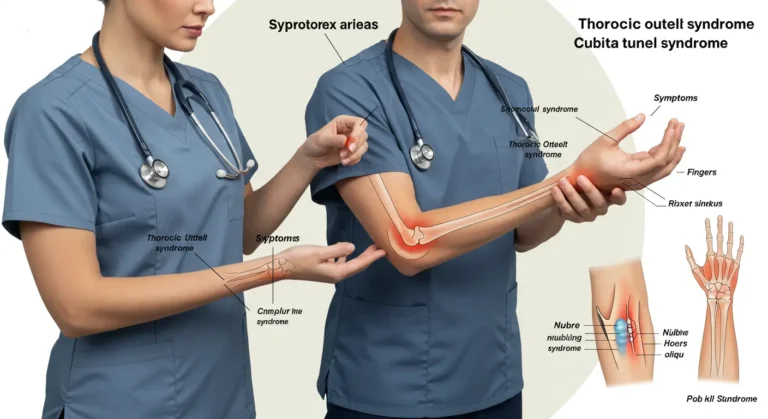Two conditions that are often misdiagnosed as carpal tunnel syndrome can lead to unnecessary treatments and prolonged discomfort. If you’ve been experiencing numbness, tingling, or pain in your hands and wrists, it’s important to know that your symptoms might not be carpal tunnel syndrome (CTS) at all. In fact, thoracic outlet syndrome and cubital tunnel syndrome are two of the most common culprits that mimic CTS symptoms.
This guide breaks down these two commonly misdiagnosed conditions, how they differ from carpal tunnel syndrome, and what to do if you’re not getting relief from traditional CTS treatments.
What Is Carpal Tunnel Syndrome?
Carpal tunnel syndrome is a condition caused by pressure on the median nerve as it travels through the wrist. Common symptoms include:
- Tingling or numbness in the thumb, index, and middle fingers
- Wrist or forearm pain
- Weak grip or hand fatigue
CTS is usually associated with repetitive hand movements, poor ergonomics, or inflammation in the wrist area. However, two conditions that are often misdiagnosed as carpal tunnel syndrome can show almost identical symptoms.
Two Conditions That Are Often Misdiagnosed as Carpal Tunnel Syndrome
Let’s explore the two most commonly confused conditions:
1. Thoracic Outlet Syndrome (TOS)
TOS occurs when nerves or blood vessels are compressed between the collarbone and first rib. This condition affects the brachial plexus, which can create symptoms similar to CTS.
TOS symptoms:
- Numbness in the entire arm or hand
- Pain in the shoulder and neck
- Weakness in the hand or fingers
Key Difference: TOS often includes neck and shoulder symptoms, which are not typical in true carpal tunnel syndrome.
2. Cubital Tunnel Syndrome (CuTS)
Cubital tunnel syndrome affects the ulnar nerve at the elbow (commonly known as the “funny bone” nerve).
CuTS symptoms:
- Tingling in the ring and little fingers
- Elbow pain, especially when bent
- Weak grip and hand clumsiness
Key Difference: Unlike CTS, CuTS symptoms are most intense in the ring and little fingers, not the thumb or index finger.
How to Tell the Difference
Recognizing whether you have CTS, TOS, or CuTS can save you time, money, and pain. Here’s a quick comparison:
| Condition | Nerve Affected | Key Symptoms | Trigger Area |
|---|---|---|---|
| Carpal Tunnel Syndrome | Median Nerve | Thumb, index, middle finger tingling | Wrist |
| Thoracic Outlet Syndrome | Brachial Plexus | Neck, shoulder, whole arm numbness | Shoulder/Neck |
| Cubital Tunnel Syndrome | Ulnar Nerve | Ring and little finger tingling | Elbow |
If symptoms don’t improve with typical carpal tunnel treatments (like wrist splints or ergonomic changes), consider asking your doctor if one of these two conditions that are often misdiagnosed as carpal tunnel syndrome might be the real issue.
Frequently Asked Questions
Can you have more than one condition at once?
Yes, it’s possible to have overlapping symptoms from CTS, TOS, or CuTS, especially if you perform repetitive arm or wrist movements daily.
How are TOS and CuTS diagnosed?
Diagnosis may involve nerve conduction studies, MRIs, or physical exams to test specific nerve pathways.
Are treatments different?
Yes. CTS treatments focus on the wrist, CuTS involves elbow support or surgery, and TOS may require posture correction, physical therapy, or vascular treatment
Read More : How Much is Invisalign UK: Affordable Options for a Perfect Smile
Conclusion
Knowing the two conditions that are often misdiagnosed as carpal tunnel syndrome—thoracic outlet syndrome and cubital tunnel syndrome—is the first step toward proper diagnosis and relief. Misdiagnosis can lead to ineffective treatments, so understanding your symptoms and seeking a specialist’s opinion is crucial.
If you’re experiencing hand, arm, or wrist discomfort and standard carpal tunnel treatments aren’t working, consider the possibility that you might actually have TOS or CuTS instead. Always consult a healthcare provider for a personalized evaluation.

